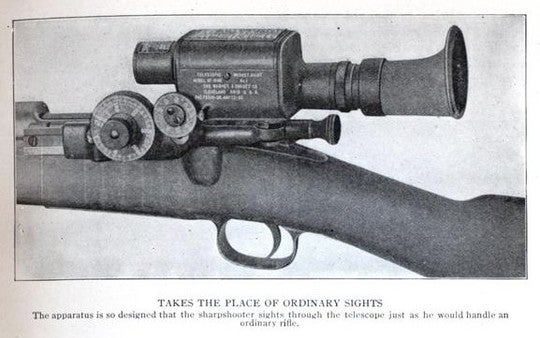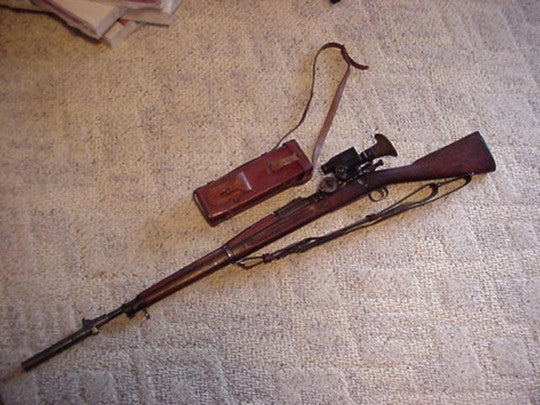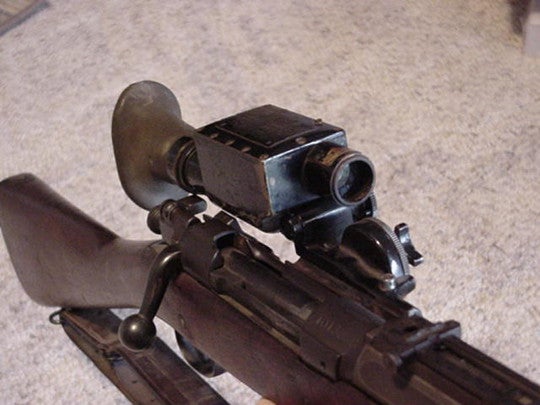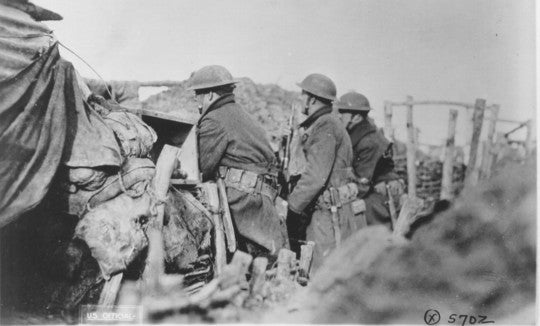An amusing article on the US Army adoption of sniper scopes was published in September 1915 of Modern Mechanix (1 year after the outbreak of WWI but 18 months before America’s entry into the war.
I must admit I love the archaic language used in this old magazine article …
… the German made the finest telescope rifle sights in the world, as he made the finest lenses and cameras and field glasses, they were confined to his hunting rifles, because before the war he labored under the delusion that fighting would be a grand shooting match between thousands of troops in the open where the mass of fire counted, and the accurate fire of a few men was not worth while.
…
The Britisher found out to his surprise that nobody in England made telescope sights worth while, so he sent in hurry-up orders to the American firm equipped to turn them out for this Government, to rustle a few over to the firing lines in Western Europe.
…
Then and there a board of American army officers, who had recommended the adoption of the telescope in 1908, sat down and chuckled right merrily. It was the first time in seven years they had had a chance to chuckle so far as the telescope sight was concerned; their judgment had been vindicated by the “flop” to their position by their most patronizing critics.
By all accounts none of the optics fielded in WWI to rifleman by any country were successful. It was not until 1941, when the German Army introduced the Zf-41, that a rifle scope was issued to regular non-sharpshooter troops (and it was also not a successful scope). Only in the 1970s did some nations adopt scopes instead of iron sights as the standard sights for their service rifles. It took until the late 90s until we saw widespread adoption of optics as a replacement for iron sights. This was not because military users were shortsighted (excuse the pun) but it simply took this long for scope technology to reach a point where scopes were practical and offered a significant advantage over cheap, easily maintained, iron sights.
Getting back to the Modern Mechanix article, the scopes in use by the US Army prior to WWI were the Telescopic Musket Sights Model 1908 and Model 1913. These scopes resembled telescopes more than modern rifle scopes. The eye lens was offset both horizontally and vertically from the objective lens, not great for accuracy or ergonomics. The bulky middle section of the scope contained a complex prism mechanism. See these photos below …
The War Department’s publication “No. 1957 DESCRIPTION OF TELESCOPIC MUSKET SIGHTS MODELS OF 1908 AND 1913″ describes how these scopes should be cared for …
Telescopic sights are necessarily delicate instruments and must not be subjected to rough usage, jars, or strains. When not in use the telescope should be kept in its pouch and stored in a dry place. It should be occasionally examined to insure its not being corroded and all traces of dust or moisture should be removed before being put away. To obtain satisfactory vision the glasses should be kept perfectly clean and dry. In case moisture collects on the glasses place the telescope in a gentle warmth; this is usually sufficient to remove it. A piece of chamois skin or a clean linen handkerchief will answer for cleaning purposes, care being taken that the cleaning material does not contain any dirt or grit…
It is not hard to see why these scopes were not popular. The maintenance manual was written by someone who had never envisioned that the scope would have to be used in muddy trenches on the Western Front.
[ Many thanks to Sven (Defence and Freedom) for emailing me the link. ]
 Your Privacy Choices
Your Privacy Choices





